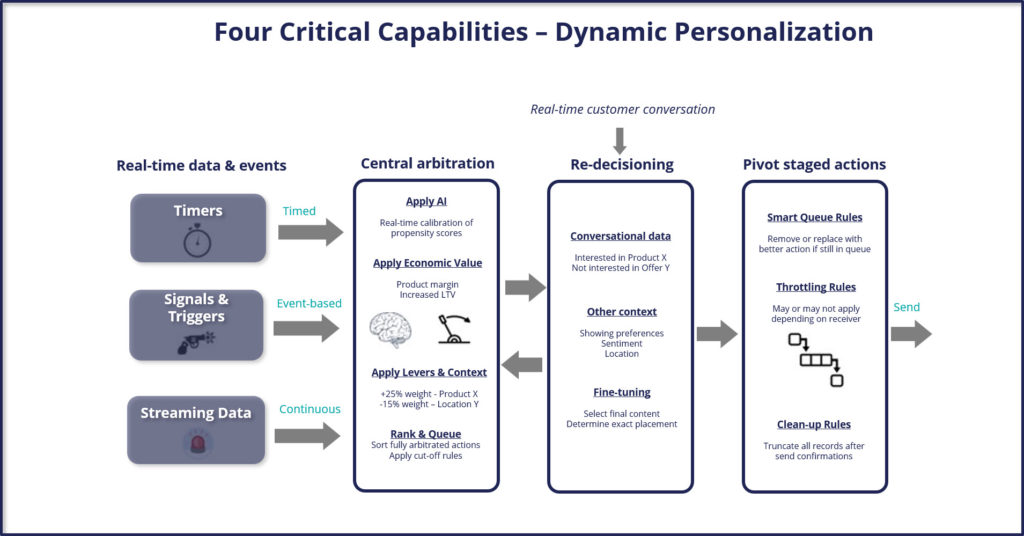Dynamic Personalization | dī-‘na-mik[i] pәrs-nә-lә-‘zā-shәn[ii]:
- Marked by continuous and productive activity; to mark as the property of a particular person
- Customizing digital content and marketing messages based on recent behavior
- Watching for recent customer signals, intent, and preferences followed by tailoring and individualizing future interactions

As a definition and concept, dynamic personalization seems relatively straightforward. A piece of cake, right?
Well, with a multitude of channels, big data, complex content production processes, audiences in the millions, a fast-moving/tumultuous world, and customers’ expectations sky-high, pulling it off may be no small feat. To do so, it will take rapidly sweeping up recent events and behaviors together with instantly incorporating them into conditional content production. That means taking on the spot decisions like what’s the next-best recommendation during a customer interaction – doing so in milliseconds.
This is the new CX battleground. As for customers’ expectations – a recent CX survey found 72% of consumers will only engage with marketing messages tailored to their specific interests. [iii]
To be fair, most major marketing clouds, such as Salesforce or Oracle, do a decent job of fetching historical customer data stored in enterprise data repositories, then using it to guide marketing campaigns. For years, this bygone data was the only fuel for the rules, strategies, and analytical models powering marketing programs. But the giants of the marketing automation landscape fell behind. Presently, their approach to personalization lacks four critical capabilities:
- Ingesting and using real-time data & events: Although today’s touchpoint & tag technologies can detect and pass on recent customer behaviors, most marketing platforms can’t swiftly absorb them. They have no way to effectively ingest massive streams of real-time customer data, at once factoring it into the action arbitration and execution process.
- Centralized next-best-action arbitration: Picking the best thing to do amongst hundreds of options is crucial when the customer shows up. Yet because the major marketing clouds bought outbound campaign management capabilities, they either predominately pre-calculate customer treatments and stage them in channels, or worse, bake treatment logic into channels. That makes it nearly impossible to coordinate decision making across channels.
- Pivoting staged interactions: When a proposed promotion is no longer best or applicable based on recent behavior (but it’s in the pipeline ready for delivery), campaign management engines can’t replace or adjust it.
- Conversational decision making: Batch marketing technologies can’t re-decision (in the moment) when customers supply real-time feedback in sessions. Instead, they supply a pack of pre-calculated treatments.
Without these key features, there’s no chance for memorable customer experiences and press-worthy hyper-personalization. Quite the opposite, expect treatments that are sub-par, irrelevant, and annoying. And bolting on a channel-centric personalization engine won’t suffice.
What’s paramount is the ability to instantly consume as well as react to the ever-changing context of recent customer behaviors and interactions – things that just happened that have a direct bearing on customers’ needs in the moment. To deliver world-class customer experiences, organizations must factor in recent data, use a central brain, then respond through any channel in real-time. Doing so (when opponents can’t) will separate brands from their competitors.
Most enterprises, regardless of their personalization abilities, generate millions of pieces of digital content every day. Sadly, many pieces are the same, not reflecting individual nuances that make for compelling content. Even when companies manage some degree of personalization, predeterminations often days or weeks in advance destines a sizable portion of it to staleness and obsolescence.
Consider a typical email campaign, which takes weeks for segmentation, targeting, and offer assignments. Suppose it’s intended to reach an audience of one million consumers. Given the number of recipients and the length of time from message/offer assignment to email open, it’s likely that five to ten percent of the content treatments that might otherwise have been relevant to their intended recipients – are no longer relevant at open time. That means 50k to 100k customers will receive irrelevant marketing messages.
A real story, please
Ok, here’s a specific scenario.
I recently toyed with upgrading my aging iPhone (I’ve been a loyal iPhone customer for years). I jumped on my provider’s website and saw offers for the latest iPhone models – what I expected. However, I began searching their site for Android deals and spent nearly an hour researching them – I wanted an Android. I started a chat, asking about Android phone offers. The chat ended because I wasn’t ready to decide, nonetheless I asked the agent to keep me informed of new offers. If there ever was a moment of truth, this was it.
Meanwhile, the marketers (unaware of the above) had campaigns set to go, and over the next several weeks, even though I telegraphed a clear preference for android phones, I got handset upgrade offers – for iPhones.
Thusly, I (along with thousands of other customers) continued to receive poorly targeted marketing offers with static and obsolete content.

Figure 1 – The four critical capabilities for dynamic personalization
How can you improve on this scenario? It’s clear-cut. Get the four critical capabilities shown in Figure 1, which we’ll explore now.
Devour, digest, and decision on real-time data & events
Consider the multitudes of customer data captured these days:
- Device type: Mobile, web, tablets, watches, IoT, etc.
- Device OS: Android, iOS, Windows
- Inputs/search terms: Key entry and voice-controlled commands
- Browsing & shopping behavior: page views, hovering, quotes, carts, apps, calculators, etc.
- Responses: Email, SMS, social, paid ads; opens, clicks, likes, shares
- Media consumption and viewing stats; video and audio consumption patterns
Still, the trick isn’t just catching this data in motion, it’s quickly making sense of it. Finding signals in the noise.
And sluggish reaction time won’t cut it. There are two vital aspects in play here: 1) Collecting the data in real-time and 2) updating aggregates in real time, and promptly passing these signals on to a decision-making system.
In discussing moments-based marketing in his March 2020 blog, Joe Cripps of Celebrus points out that doing dynamic personalization requires a solution that can “provide millisecond connectivity – the data that we capture flows directly into enterprise systems of insight and engagement.” [iv]
Ergo, tap into this data and directly wire it into your dynamic personalization system.
Centralize next-best-action arbitration
Column one in Figure 1 outlined the arbitration process. Figure 2 below zooms in on it:

Figure 2: Centralized arbitration process
First (and imperatively) centralize this process, abstracting it from channels. Second, put filtering criteria, such as offer eligibility, before it for efficiency. In other words, only send in the surviving actions.
Arbitration starts when timers, triggers, signals, or re-decision events request mediation work. Moving left to right, centralized arbitration uses these four steps to arrive at next-best-actions:
- AI – adaptive models that forecast the probability of a customer to respond to an action
- Value assessments – the calculated value of each action to the business
- Levers & context – human-programmed adjustments (weights) given to actions and the contextual data received in session payloads
- Rank & queue – Sorting the actions and sending the requested number to a given destination
Like the human brain, centralized arbitration doesn’t think in batches – once a week, once a day, or even once an hour. It goes through this process in a split-second – for every individual every time they interact, or an event signifies there’s a reason to act.
For an enterprise with millions of customers, this means thousands of arbitrations per second, with each one performed in milliseconds.
Despite sounding space-age and complex, in practice, the business can easily set up and control centralized next-best-action arbitration with a modern real-time interaction management (RTIM) platform.
Re-decision during conversations
We’re all consumers. When we fetch our smartphone from pockets, jump on websites, or chat with agents, we start conversations. In that process two very important things happen:
- We show brand-new behavior and intent
- We give and get feedback
Granted a long-running conversation can happen over many sessions, with time between sessions to re-group, deliberate, and change course. But during a session, which might last minutes or seconds, there is precious little time to alter decisions.
Adjusting decisions instantaneously, that is making fresh recommendations as a business gathers new information, is an essential and unique capability. Back to our phone shopping story. I started my web session seeing iPhone offers – fully expecting this. During the session, however, I displayed clear interest in Androids. Still, my provider didn’t pick up on this and never re-decisioned. In that session, I wasn’t feeling tailored to or special.
Pivot staged interactions
It’s important to do pre-work, queuing up components in preparation for an upcoming program like an outbound email campaign. It drives efficiency, such as when restaurants prep food, manufacturers pre-order parts, or the internet stages content (think CDNs). But when that process pre-determines final offerings and treatments, event-time dynamic personalization isn’t possible. As a result, many consumers see stale (day-old) content not tailored to their specific and latest interests.
For personalization to be efficient and effective, organizations must prep message components plus make last-second adjustments. At times, they’ll need to pull back, adjust, or even reverse decisions. In short, they must dynamically assemble final recommendations married with content at interaction time.
To illustrate, take the case study of Victra – an authorized Verizon retailer. After factoring in one simple data element, device location, and making email open-time adjustments using Movable Ink, they realized 200 – 300% higher engagement in email campaigns.[v]
Conclusion
In early 2019, Forrester predicted:
“Enterprise marketing technology will meld with customer experience (CX) investments to deliver the relevancy and consistency that consumers crave from brands.” [vi]
Shortly after, Forester’s Rusty Warner went on to write,
“Real-time interaction management (RTIM) provides critical capabilities that enable marketers to realize their CX ambitions.” [vii]
And as we’ve learned, it takes four key capabilities for dynamic personalization:
- Get and use real-time data
- Arbitrate next-best-actions in real time
- Re-decision in the moment – during customers’ conversations
- Do homework, be prepared, plus make game-time adjustments
Cover these in your CX strategy and RTIM technology selections to give consumers what they crave – dynamic personalization.
[i] Merriam Webster, https://www.merriam-webster.com/dictionary/dynamic, 2020
[ii] Merriam Webster, https://www.merriam-webster.com/dictionary/personalization, 2020
[iii] SmarterHQ, https://smarterhq.com/privacy-report, 2020
[iv] Celebrus, https://www.d4t4solutions.com/data-capture/blog/business/true-moments-based-marketing-needs-to-happen-in-the-moment/, March 2020
[v] Movable Ink, https://movableink.com/clients/technology/victra, 2018
[vi] Forrester, https://go.forrester.com/blogs/tag/predictions-2019/, 2019
[vii] Forrester, https://go.forrester.com/blogs/enable-marketings-cx-ambitions-with-real-time-interaction-management/, 2019



